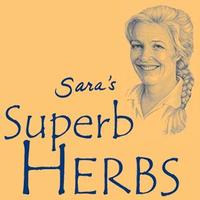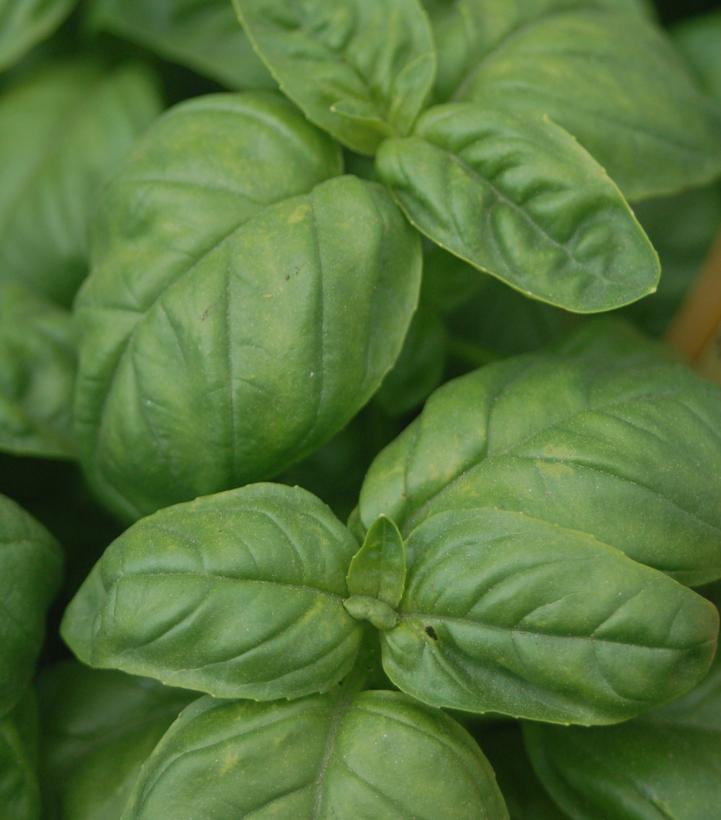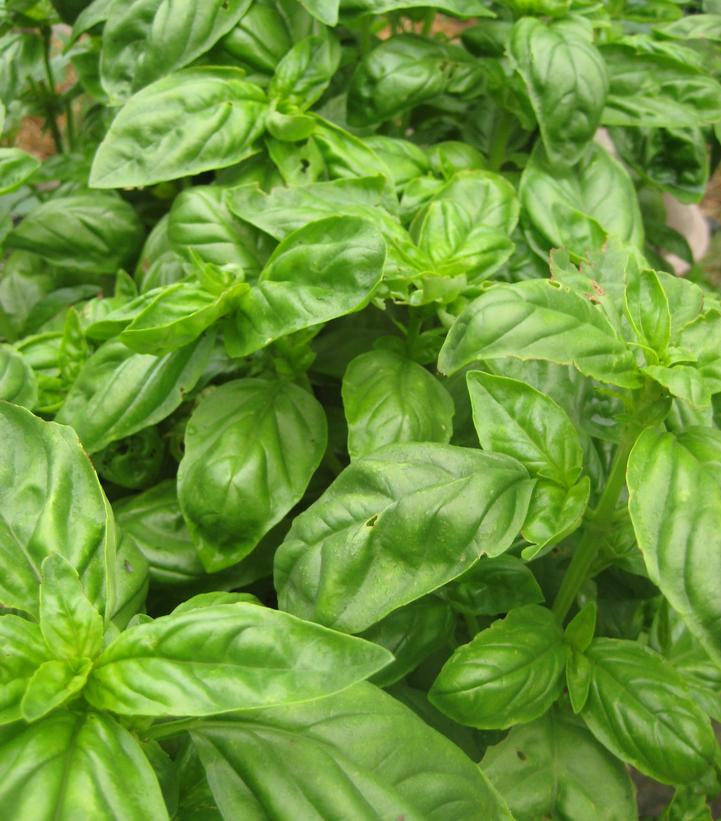« Previous Plant | Next Plant »
Ocimum b. 'Genovese'
Green Basil
- » Shiny, cupped green foliage
- » Strong aroma and taste
- » Great on deck containers or windowsills
- » Pinch continually to prevent blooming
- » Annual

- Category:Edibles
- Breeder:Sara's Superb Herbs®
- Hardiness Zone:8-10
- Height:18-24 in
- Spread:12-15 in
- Bloom Color: Green Shades
- Foliage Color: Green Shades
A culinary must, this herb's shiny, cupped green foliage is prized for its strong aroma and taste in all Italian foods, fresh tomato salads and pesto. Genovese basil craves a sunny, warm garden spot and thrives in containers on a deck or a sunny kitchen windowsill. Continually pinching is very important to prevent blooming, which radically alters the taste of the plant and makes its flavor less desirable. Annual.
Additional Information about Ocimum b. 'Genovese'
Ocimum basilicum 'Genovese' is an annual native to India, Africa, and Asia. One of the most popular herbs, it is now cultivated in all temperate climates throughout the world. Of all the basils to grow, and there are about 150 varieties, Genovese basil is one of the best because it yields 7 to 8 cuttings and makes the best pesto.
In Italy, it is considered a sign of love. When a woman puts out a pot of basil, it means she is ready to receive her suitor. In France, it is called herbe royale. In India, it is sacred, dedicated to Vishnu and Krishna. In Victorian times, it was sent for best wishes in nosegays called tussie-mussies.
Harvest and Use: Though used mainly as a culinary, there are many other possible uses for basil. Try a cup of basil tea as an after dinner drink to aid digestion and expel gas. Basil tea is also good for stomach cramps and vomiting. An extract from the seeds has been shown to have an antibacterial effect. Combine it with wood betony and skullcap for nervous conditions or with elecampane and hyssop for coughs. Rub leaves on insect bites to reduce itching.
Basil essential oil has many aromatherapy uses. A drop on the sleeve can be inhaled for mental fatigue. Combine it with hyssop, bergamot or geranium oils for a stimulating massage oil for depression. Blend 6 to 8 oz of stimulating herbs (herbs such as thyme, sage, rosemary, mint, lemon verbena, lavender and/or marjoram) in a muslin bag to steep, for an invigorating herbal bath in cool water. Or, make a strong infusion of the herbs and add to the bath water. Researchers have found water slightly below 98 degrees is best for a stimulating bath.
Holy basil, opal basil, and lemon basil leaves may be added to potpourri. They are especially heavily scented. Opal basil with its iridescent purple foliage and mauve flowers adds a beautiful accent and fragrance to a bouquet. Brunettes can add shine to their hair with a basil/rosemary rinse. Blonds can do the same with a chamomile/basil rinse. The cosmetic industry uses basil in lotions, shampoos, perfumes, and soaps. It is also an ingredient in the liqueur Chartreuse.
Further Reading: For basil fanatics such as I, further reading is a must and Basil: An Herb Lover's Guide by Thomas DeBaggio and Susan Belsinger fits the bill. It contains an extensive and in-depth description of about 45 basil varieties along with recipes for varieties other than the most common sweet basil.
Growing & Maintenance Tips for Ocimum b. 'Genovese'
Cultivation: Basil represents the essence of the summer garden. It is not hard to grow from seed, which germinates readily at temperatures between 75-85 degrees. Contrary to most cultivation information on basil, it does not mind slightly acid soil or partial shade. As a matter of fact, it will do best in an area protected from the wind and scorching midday sun. It likes rich, well-drained soil and will grow best in soil enhanced with well-composted manure. It hates cold and should be planted out only when night temperatures reach 50 to 55 degrees. If you practice companion planting, plant basil near tomatoes and peppers to enhance their growth.
Pinch it back early and often to encourage bushiness. Do not let it flower unless you want to let it set seed as this destroys the flavor and shortens the lifespan of the plant. Many save this "end of the season" basil, the one that is always trying to go to seed, for pesto. I suggest you try making pesto from prime leaves at least once, to compare flavors.
Pests: I am always amazed that such a delicious smelling and tasting plant has few pests when grown outdoors: Japanese beetles and slugs, to be precise. Japanese beetles can be hand picked in the early morning when they are still sluggish from the cold. Beer traps, (shallow dishes of cheap beer placed close to the plants every 3') drown slugs that crawl into them. On the other hand, if you are growing inside, in a greenhouse, or on a windowsill, you must watch for aphids and whiteflies. Both can be dislodged with a jet spray of water or sprayed with horticultural soap.

